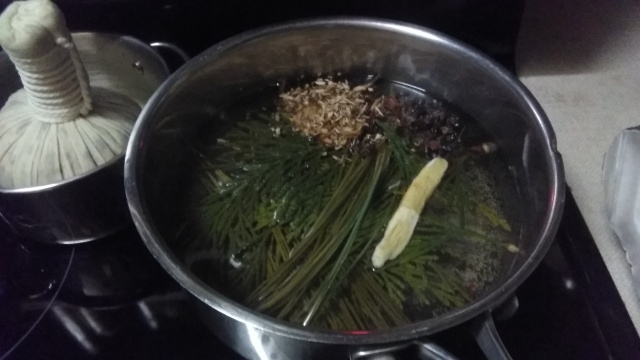
*If you like this recipe, you may like this free downloadable book: Tree Medicine for Our Human Family
While the United States is struggling with how to deal with 2019 novel coronovirus disease, and the CDC and WHO are warning that this has become a global pandemic, and Congressional doctors are warning that 70 million to 150 million people in the United States may contract the virus, and the death rate is estimated to be between 1% and 3.4%, I wanted to write about pine needle tea and how you can use it as a defense for viral infections as well as the respiratory symptoms that arise in most coronavirus cases.
Pine needle tea is an expectorant and a decongestant, which means that it will loosen up mucus not just in your sinuses, but in your lungs, and it will help that mucus naturally rise up so you can spit it out.
Although most people who are hospitalized for coronavirus are over the age of 50, there are also certain high-risk groups of people and that includes people with asthma (who already deal with closed airways and extra mucus production), people with cardiovascular issues, and people who are immunocompromised. Smokers are considered higher risk as well, possibly 14x more likely to progress to life-threatening pneumonia if they contract coronavirus.
A cup of pine needle tea is estimated to have substantially more vitamin C than an orange. Older pine needles have more vitamin C than young needles. New pine needles are slightly denser in vitamin C than oranges; one-year-old needles have twice as much vitamin C, and two-year-old needles have about 3.5 times more.
I like to add other ingredients such as white willow bark, which contains Salicin (similar to Aspirin’s primary compound, acetylsalicylic acid) and is anti-inflammatory and pain-relieving; astragalus root, (an adaptogen with antioxidants, antibacterial, anti-inflammatory, and antiviral properties); and rose hips (high in vitamin C, anti-inflammatory, antioxidant), which are featured with pine needles in the photo above.
It is very difficult to mess up a simple pot of pine needle tea, and pine trees exist all over the world. So as long as you remember this very important fact: you can use pine needles from any pine tree, EXCEPT for Yew (genus Taxus), and you need to avoid Yew pine (Podocarpus macrophylla) as well as Norfolk Island pine (Araucana heterophylla). Additionally, pine needle tea may be contraindicated for pregnant women, as pine needles are considered (mild) abortifacients, meaning that they can cause a woman to abort.
My favorite pine to use is Cedar, mixed with other pine needles such as Jeffrey, Spruce, Sugar, etc, whatever you can find. I’ve made pine needle tea in one-person camping pots (such as for a video I once sent to Naked and Afraid after being contacted by a casting director in 2014), and I’ve made pine needle tea for six people in a massive stainless steel pot meant for large dishes.
How to make pine needle tea:
1) Gather about 1/4 cup of pine needles per cup of water.
*Try to be conscientious when you take anything directly from a tree. Never gather from young or sparse trees that will be affected from your harvest, and never take more than three sprigs from a single plant. Always give thanks to the plant for providing for you. An alternative is that you can look for fallen sprigs that are still green and attached to branches. Those are still alive but won’t affect a living plant if you take them.
2) Place the pine needles in the pot of water and cook on a low heat, so that the water does not simmer or boil.
* You do not want to overheat the water because it will release bitter terpenes and reduce the nutritional composition of the plant material.
3) Keep the water on low heat for upwards of an hour.
* The longer it sits, the stronger the tea will get. You can keep the tea in the fridge for a few days, but I recommend straining it after 24-hours so that it keeps longer. Serve the tea with honey or plain, or however you like to drink tea.
A final note about this tea: I have been a certified herbalist (herbologist) since 2006. I specialize in both internal and external plant medicines and have received certifications from Princeton Consumer Research for external plant-medicine based applications. I’ve been interested in plant medicine since I was a child, and have continuously depended on my own plant knowledge to treat chronic pain and an autoimmune disease. I also have had a seemingly endless list of injuries that has led me to deal with regular migraines and pain (such as a 400-foot fall down a Yosemite gully on my snowboard), and I understand fully what it feels like to be dependent on something such as Ibuprofen. However, there is a common misconception, and it is untrue, that all pharmaceuticals are more efficient or powerful (or safe) than plant medicines. For instance, white willow bark tea is just as powerful as 800 mg of Ibuprofen for me, and that says a lot. While I still carry around Ibuprofen, I prefer tea because I know exactly what is in it, and it is just as effective. Pine needle tea generally starts working after the first cup, but I recommend making enough so that you can drink at least three over the course of a day or two, if not more.

Thank you for the gift.
LikeLiked by 1 person
Honora it is SO cool that you knew all that, and even cooler that you posted it as a public service!
How about a post telling what you do these days? Work? Play? Camping? Also maybe how you got into primitive survival.
I sure hope you publish your book.
LikeLike
I absolutely will try this, I had it once when I was younger. Thanks for sharing!
LikeLiked by 1 person
You’re very welcome. Thank you for accepting the share! 🙂
LikeLike